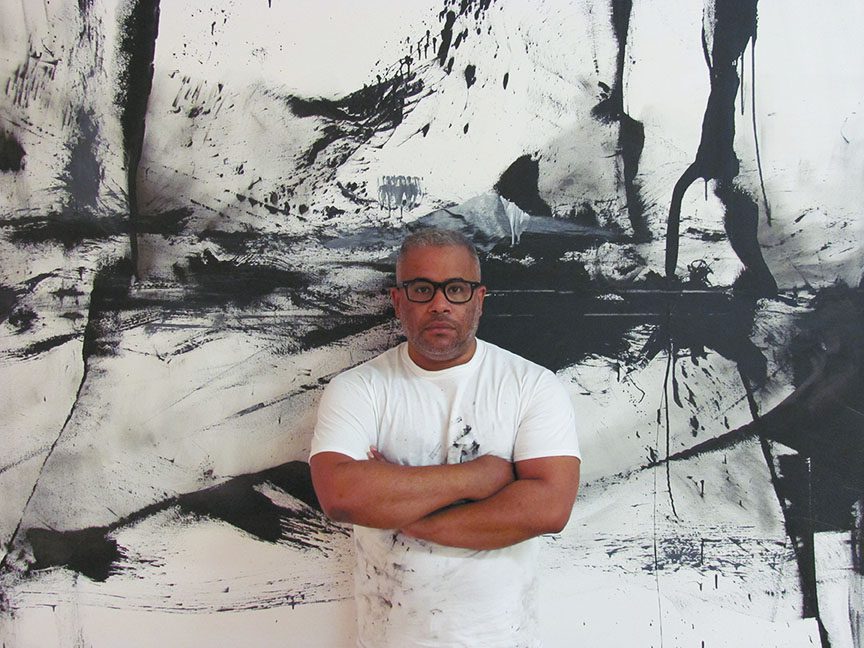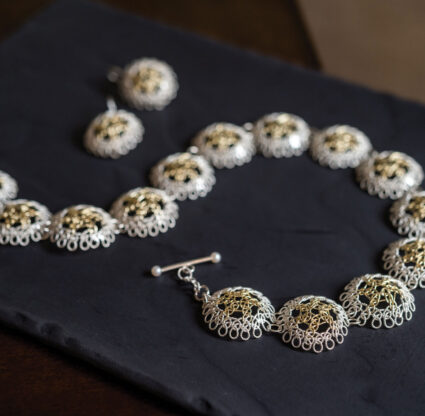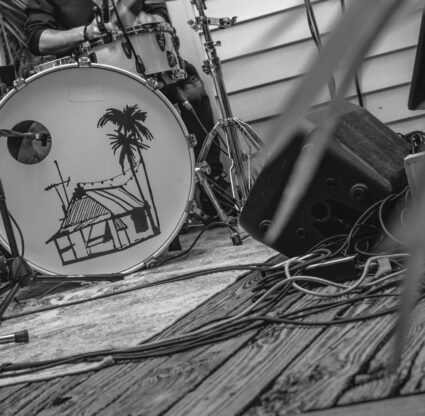For someone not schooled in modern art, a trip to Unit A Space in Fort Myers can be, well, a little intimidating.
You won’t find pretty landscapes or straightforward portraits hanging on the walls. Instead, you’ll witness explosive works of color, imagery, mood and ideas that seem to originate in a sleep-disrupting dream: a polka-dotted ball, a delicate white animal, a faceless man, a hunched figure clinging to a life ring. Is that water about to swallow him up, or is it receding?
 |
|
When History Repeats |
It’s whatever you want it to be.
That’s what Marcus Jansen, the artist, would tell you if he were there, and lucky for us, he was there one afternoon in late spring, taking a break from his adjacent studio where he was working toward an international solo museum tour—his first. Jansen arrived in Lee County a decade ago already a well-respected artist, but in the last couple of years he’s accumulated a growing list of accolades, including international prizes, museum permanent collections, solo gallery shows and commissions.
“I’m not a painter who likes to dictate,” he explains, strolling through his warehouse-like exhibition space. “A painting is not a dictatorship. It’s a free realm for investigation.”
There are no descriptors revealing his intent or even titles posted besides the works (if you really want to know them, you’ll have to look at his website)—nothing that might skew one’s personal reaction.
“Who am I?” he continues. “I’m just like everybody else. Anybody’s vision is valid. It’s how you see things.”
His philosophy immediately begins to snuff out the intimidation factor. And if any of it lingers, his appearance and approachability extinguish the rest. Sure, Jansen is an intellect, but he’s also the kind of guy you could imagine joking around at a neighborhood barbecue. And, he’s wearing a Snoopy T-shirt.
Hints of that playfulness are scattered in the paintings: a ball, a balloon, a stray toy. He likes paradoxes.
The works otherwise are serious business.
 |
|
Faceless series |
Jansen has a worldview more extensive than that of many Americans. The son of a German father and Jamaican mother, his childhood straddled New York City, where his mother was raised, and his father’s homeland. Jansen spent eight years in the U.S. Army, rising to sergeant. He served in the first Gulf War, in Vietnam’s demilitarized zone and capped off his career back in Germany. But, increasingly, his inner values clashed with the military complex he had pledged to serve. When it came time to re-enlist, he got out. Jansen had not painted in years—a soldier’s life offers no time or space for artistic reflection—but when he picked up his brushes again, a torrent of ideas began to cascade.
“We’re in times of conflict,” he says. “Of course, the average American is not in tune with it because the conflict is never here. It’s always … a distant notion because the conflict is far away,” Jansen says.
He pauses in front of one of his latest works. War has become a game for the powerful nations, he muses. It’s the primary-colored toy bulldozer mocking a gray, naked trio of people.
“It’s a real scenario but … it looks like a sandbox to me. Almost like you could see a kid playing with toys, and that’s kind of how people who wage war see it,” Jansen says.
Notice his word choice—“it looks like a sandbox to me,” not “it’s a sandbox” or “I meant it to resemble a sandbox.” Jansen’s works surprise him as much as they do everyone else.
Jansen will do background research on the topics that matter to him, but he doesn’t pre-plan his paintings or do preliminary sketches the way academically trained painters might (he dropped out of a German art institute because he found the instruction too rigid). Instead, Jansen’s brush strokes are an expression of his subconscious—like a writer’s stream of consciousness or a dancer’s improvisation.
“Art is about possibility,” Jansen says. “To me, it’s always been about a search-and-find mission. … You make one brush stroke. You react to it. You make another. You react to that. It’s an accumulation of brush strokes that wind up adding up to something intellectually and spiritually … and then you present it. That’s impossible if you’re calculating.”
Ray Hignite, a family friend who headed the renovation of Unit A, has seen him stare at a painting for a half-hour before adding a single mark.
Jansen had a hint of his process on display that day—a tall, vertical canvas streaked with bold, black brushstrokes. This is how his works begin. If he were to complete the painting, he would study the shapes and lines he’d just made until a concept emerged. You could do the same thing yourself, he encourages. See what the images say to you.
Jansen would be pleased if he had been at his gallery during an Art Walk event a few days later. A group of people clustered around one of his more apocalyptic works, engaged in a deep discussion about what it might mean and, more importantly, what it means to them. Is that the Christ child? Who is the shrouded figure with hands outstretched? What does the lamb-like figure signify? Innocence? Naiveté?
“There’s a pain so evident in these people,” remarks one viewer, Ivan Seligman.
“It’s all a wake-up call, really,” adds Patricia Esposito, another frequent Unit A visitor.
Tonda Soisson-Lawson, Hignite’s daughter, sees this kind of conversation unfold all the time. She and her parents help host the monthly Art Walk events at Unit A.
“I’ve seen people standing there and weeping in awe of the emotions,” Soisson-Lawson says. Whatever moods and experiences they bring into the space are reflected back at them. “What he does touches people. It moves people, it changes them and even changes the way they see themselves.”
Jansen’s solo museum exhibition will travel to Rome, Beijing and New York. It’s the kind of opportunity artists aspire to—and one that only the best achieve.
“Although you always hope to get to places, I never thought I would be anywhere near where I am—not from where I came from, not from where I started,” Jansen says.
Jansen’s artistic talents emerged early—he had his first public display at age 6 when his painting was chosen for a student art exhibition in New York. When he was 10, his parents moved to Moenchengladbach, Germany, a small, working, mostly homogenous city. A biracial Jansen and his brother were suddenly thrust into a new culture, new language, new school.
“I wasn’t exactly the most popular person in school. I was the odd one,” Jansen says.
A visit to New York in 1982 during the birth of the graffiti movement proved a turning point. Jansen, then 14, remembers seeing drab subway trains suddenly awash in color. “I thought it was just so amazing, so vibrant, so colorful.” He took the newfound art form back to Germany. “I went from nobody really paying attention to me to, ‘Oh, my gosh, what is that?’ Before you knew it, I was getting paid jobs.”
Jansen graduated high school, briefly attended the German art academy, and when he decided against that, he took an apprenticeship as a house painter. There, he learned about enamels, his preferred medium, but grew creatively listless. He was introduced to the military by a girlfriend’s father and believed the structure would be good for him. “At that point, I was sort of all over the place,” he says.
The Army did indeed focus him—for a while. “I started having a lot of questions about what we were doing and why we were doing it. … Everything in the military goes against your morals because you’re trained to kill. That whole point is not addressed too much.”
Jansen met his wife-to-be Michaela during his final military assignment in Germany. She encouraged him to pursue art. He returned to New York to see if he could make it; a hypercritical German art scene was virtually impossible for an unknown. “It was a do-or-die situation,” he says. He sold his work in the streets for anything from $20 to $500. John Ortiz, the actor, was the first to make a purchase.
Buoyed by the encouragement he was receiving, Jansen married Michaela and settled down near Atlanta to make a go of professional artwork. His career stalled—as did the rest of the art world’s—in the wake of the Sept. 11 terrorist attacks and then leapt forward with a commission from the Ford Motor Co., which wanted a painting celebrating its 100th anniversary.
Jansen never cared for Atlanta and instead was drawn to the beaches of Southwest Florida. He did his first showing locally at the Arts for ACT gallery in downtown Fort Myers. “It was a huge success, and this was at a time when nobody was doing contemporary stuff down here. I mean nobody. It was palm trees and beaches and all that kind of stuff.’”
The exhibit caught the eye of one rather famed art expert, Jerome Donson, former director of the Museum of Modern Art and the Metropolitan Museum of Art. Donson, who had retired to Port Charlotte, had attended a play at the neighboring Florida Repertory Theatre when he glimpsed Jansen’s display.
Donson dubbed Jansen the originator of a new movement, “urban expressionism,” a term that stuck.
“I believed that there will be many followers in this new style. But there will only be one Marcus Jansen,” Donson wrote in the forward for Modern Urban-Expressionism, a 2006 book celebrating Jansen’s works.
“It was a huge boost for me, and a validation of my work,” Jansen says.
Jansen went off the radar locally as he and Michaela celebrated the births of their two sons. The artist continued to show internationally; few realized he lived in Fort Myers, not New York.
“We have watched him become world-famous and blossom into amazing things. To us, he’s just Marcus. To the world, he’s Marcus Jansen,” Soisson-Lawson says. An insurance agent, Soisson-Lawson had been called in to help figure out how to get better insurance coverage for Michaela, who’d been diagnosed with cervical cancer. She succeeded in doing so and in the process developed a lasting friendship with the family. Michaela Jansen’s battle was sadly short; she died in 2011.
Unit A was born in the wake of that loss. Soisson-Lawson’s family and Jansen worked to transform the space, a former machine shop turned chapel, into a bright, white exhibition hall resonating with Jansen’s trademark urban, industrial vibe.
It’s where Jansen mingles with area residents, meets with local artists and displays his newest works before shipping them off to galleries or museums or private owners.
 |
| Faceless series |
He wants his viewers to think—about government surveillance, drone warfare, loss of personal freedom and privacy, growing corporate interests in the war business. “Do you want to substitute your freedoms for a sense of security?” he asks. “There can always be claims that there’s a threat looming. It’s a very dangerous road if we start supplementing our freedom for a sense of security.” One work, Homeland Security, depicts a rather dejected-looking figure illuminated by a beam of light from an unseen source above. His Faceless series forces viewers to question authority. A professor preaches 5 + 5 = 11. An art dealer cocks his featureless head at an almost jeering angle—Jansen’s not-so-subtle commentary on the business of art. A soldier with a reptilian-like head stands in front of an American flag. The nametag is fading. It is Jansen’s name.
“The closer somebody gets to his own personal journey, the more universal it becomes,” remarks fellow artist Lawrence Voytek. “It seems you can tap into things that are true to humanity when you are sensitive to what you think is really important.”
Jansen’s been cautioned numerous times that his message-driven, emotionally hefty work won’t sell. It does now, of course with his growing international attention, but money never drove him.
“(Art) is a way of digesting what we maybe see every day on the news, but you don’t have time to digest anything because they hammer you with information,” Jansen says. “With any good painting, you should be able to stand in front of it and learn something new. … Whether people like the work or not is totally secondary. Does it give you something more than what you came in with? If I did that, then I did my job.”





